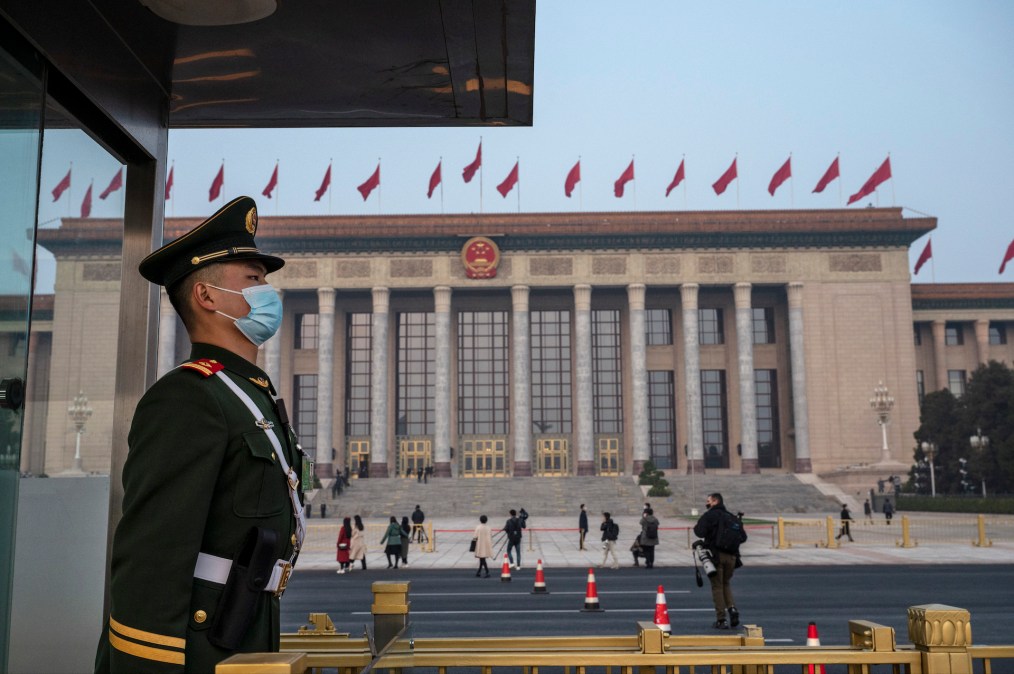Eric Lipton
A symphony of sorts echoed through the sprawling shipyard on the Gulf Coast of Mississippi — banging, hissing, beeping, horns, bells and whistles — as more than 7,000 workers hustled to fill orders fueled by the largest shipbuilding budget in the Navy’s history.
The surge in spending, $32 billion for this year alone, has allowed the Huntington Ingalls shipyard to hire thousands of additional people to assemble guided missile destroyers and amphibious transport ships. “More ships are always better,” said Kari Wilkinson, the president of the shipyard, pointing to the efficiencies that come with a steady flow of contracts and the jobs they create.
But the focus from Washington on producing a stream of new warships is also creating a fleet that some inside the Pentagon think is too wedded to outdated military strategies and that the Navy might not be able to afford to keep running in decades to come.
Half a world away, at a U.S. Navy outpost in Bahrain, a much smaller team was testing out a very different approach to the service’s 21st-century warfighting needs.
Bobbing in a small bay off the Persian Gulf was a collection of tiny unmanned vessels, prototypes for the kind of cheaper, easier-to-build and more mobile force that some officers and analysts of naval warfare said was already helping to contain Iran and could be essential to fighting a war in the Pacific.
Operating on a budget that was less than the cost of fuel for one of the Navy’s big ships, Navy personnel and contractors had pieced together drone boats, unmanned submersible vessels and aerial vehicles capable of monitoring and intercepting threats over hundreds of miles of the Persian Gulf, like Iranian fast boats looking to hijack oil tankers.
Now they are pleading for more money to help build on what they have learned.
“It’s an unbelievable capability — we have already tested it for something like 35,000 hours,” said Michael Brown, who was the director of the Defense Innovation Unit, which helped set up the unmanned drone tests in Bahrain. “So why are we not fielding that as fast as possible?”
Image
The U.S. Navy has been testing an unmanned aquatic drone, made by Ocean Aero, in Bahrain.Credit...Andrea DiCenzo for The New York Times
The contrast between the approaches in Pascagoula and Bahrain helps to illustrate one of the biggest challenges facing the Navy.
At no moment since World War II has the service faced a more urgent demand to embrace new technologies and weapons systems, given the rising threat from a now formidable Chinese military.
The Navy’s top brass talks frequently about the need to innovate to address the threat presented by China. The Defense Department’s own war games show that the Navy’s big-ship platforms are increasingly vulnerable to attack.
But the Navy, analysts and current and former officials say, remains lashed to political and economic forces that have produced jobs-driven procurement policies that yield powerful but cumbersome warships that may not be ideally suited for the mission it is facing.
An aversion to risk-taking — and the breaking of traditions — mixed with a bravado and confidence in the power of the traditional fleet has severely hampered the Navy’s progress, several recently departed high-ranking Navy and Pentagon officials told The New York Times.
“The U.S. Navy is arrogant,” said Lorin Selby, who retired this summer as a rear admiral and the chief of naval research after a 36-year career in which he helped run many of the Navy’s major acquisition units. “We have an arrogance about, we’ve got these aircraft carriers, we’ve got these amazing submarines. We don’t know anything else. And that is just wrong.”
Resistance to risk-taking and change for the military can also be found among members of Congress.
Leadership on Pentagon budgets on Capitol Hill is dominated by lawmakers from shipbuilding communities like Senator Roger Wicker, Republican of Mississippi. The industry directs tens of millions of dollars of campaign contributions to key lawmakers and mounts lobbying campaigns pushing the Navy to build more ships.
In just the past eight years, Congress has added $24 billion in extra money to build ships, more than any other part of the Pentagon budget, even as lawmakers have cut spending on repairs to the fleet, according to an analysis by the Center for Strategic and Budgetary Assessments.
Congress has also balked at efforts to retire older ships that the Navy says provide only marginal warfighting capacity, leaving the service at risk of not being able to afford basic maintenance and staffing costs.
The result, officials acknowledge, has been to bring into focus how slow the Navy has been to provide the funding and attention to the rapid innovation that many analysts say is necessary — even as money pours into conventional shipbuilding programs.
Capt. Alex Campbell of the Navy, whose job this year has been to find ways to buy cheaper, faster, more innovative technology, said the amount of money that had been allocated to the effort so far was minuscule.
“It’s the dust particle on the pocket lint of the budget,” he said.
No one is arguing that the Navy no longer needs traditional warships; in fact, a large fleet of fast-attack submarines would be particularly vital in any conflict with China.
To many analysts, industry executives and current and former military officials, the open question is how quickly the Navy can embrace the tactical opportunities by also arming itself with a new generation of weapons that are more maneuverable, cheaper to build and less devastating to lose. Even as the big shipyards are booming, companies that make unmanned platforms like those being evaluated in Bahrain are struggling to remain afloat.
“Right now, they are still building a largely 20th-century Navy,” said Bryan Clark, a former Navy budget planner who serves as a consultant to the service.
Adm. Michael M. Gilday, who previously served as the chief of naval operations, conceded that the Navy had been taking baby steps as it tried to revamp its approach to warfighting.Credit...Tom Brenner for The New York Times
The biggest barriers to transforming the Navy include its antiquated procurement system, which takes years to build out detailed specifications for new ships and then years more to get money allocated to build them.
The Navy must also radically revamp the way it organizes its fleet, critics of the current system say, to better allow its large platform ships to operate alongside a diverse fleet of unmanned vessels to better collect information on threats and instantly launch attacks.
Commanders who are comfortable with decades-old tactics and concepts are having a hard time accepting the need for changes, several recently departed Navy officials said.
Navy leaders have said they are committed to shifting to a new operational approach they are calling “distributed maritime operations,” a combination of traditional ships and unmanned drones that will allow them to spread out their forces.
In a statement to The Times, Carlos Del Toro, the secretary of the Navy, said the service had made “profound progress” over the past two years in starting to modernize its fleet. It is preparing to take additional steps soon, he said, including the creation of a unit called the Disruptive Capabilities Office.
“I am doing everything in my power to ensure that we stay at the forefront of building the warfighting capabilities and industries of the future,” said Mr. Del Toro, a former commander of a guided missile destroyer built in Pascagoula. “We are committed to innovation and advancing technological advances to maintain our strategic edge as a nation.”
But Adm. Michael M. Gilday, who until last month served as the chief of naval operations, conceded that the Navy had been taking only cautiously measured steps.
“Revolutionary change is really hard, and we’ve learned sometimes the hard way when we move too fast, we make big mistakes,” Admiral Gilday said in a speech this year. “And so our path really has been more evolutionary. It’s been more deliberate, but it has been focused.”
A Mississippi Empire
More than 7,000 people work at the Huntington Ingalls shipbuilding yard in Pascagoula, Miss.Credit...Annie Flanagan for The New York Times
Thousands of workers in hard hats pour through the gates at the Huntington Ingalls shipyard in Pascagoula before the pre-dawn horn sounds at the start of a shift, offering a regular reminder of what an enormous operation the shipbuilding effort is here — the largest manufacturing employer in Mississippi.
The most prominent of the four classes of ships the shipyard produces are the Arleigh Burke guided-missile destroyers, 509-foot vessels that are considered the workhorses of the Navy.
The destroyers can handle a range of missions, including hunting down and destroying enemy submarines, attacking other ships in nearby waters and firing precision missiles to strike far-off targets on land. The Navy already has 73 of them and has deals to build 16 more, at a price tag of about $2 billion apiece.
The ships are built one chunk of steel at a time.Credit...Annie Flanagan for The New York Times
A welder fuses different sections of steel together.Credit...Annie Flanagan for The New York Times
Four different classes of military ships are built at the shipyard in Pascagoula.Credit...Annie Flanagan for The New York Times
Congress approved a $32 billion burst of spending for the Navy this year.Credit...Annie Flanagan for The New York Times
The problem is that despite their awesome power, these types of destroyers, like certain other traditional warships, are increasingly vulnerable — especially in a conflict with China over Taiwan, according to repeated war game exercises conducted by the Pentagon, its contractors and outside consultants.
China has built up its own navy and air force, as well as an elaborate network of anti-ship missiles along its southern and eastern coasts and on islands it has constructed in the South China Sea.
The risks to U.S. Navy ships in any conflict in that region are so severe that the United States is left with two undesirable options, according to researchers at RAND Corporation, a think tank that has run a series of war game exercises for the Pentagon.
If the Navy ships choose to approach China, many will be hit by Chinese missiles and damaged if not destroyed, resulting in lost U.S. ships and casualties on a scale unseen since World War II, the war games repeatedly concluded.
“We lose a lot of people, we lose a lot of equipment, we usually fail to achieve our objective,” David A. Ochmanek, a former deputy assistant secretary of defense who now works at RAND, said during a public discussion of some of the research, a summary he reiterated in a recent interview.
Alternatively, the ships will stay hundreds or even thousands of miles from the area, making it much harder for Navy aircraft or missiles to reach their targets and leaving the initial engagement largely to Air Force bombers, Navy submarines and some long-distance Navy strikes, the war game exercises concluded.
“What it comes down to is, in many cases, the Navy surface fleet doesn’t play a major role,” said Michael Bohnert, a war games engineer at RAND.
One of the best ways for the Navy to counter this challenge, Mr. Ochmanek said, would be to rapidly deploy a fleet of armed, unmanned vessels and drones that can get close to Chinese targets. But, he added, “I have not been impressed with the speed at which they’re moving on that.”
Instead, the debate in Washington remains largely focused on protecting and expanding traditional platforms.
The Pentagon this year proposed delaying the purchase of one of the ships, known as an amphibious transport dock, that Huntington Ingalls builds at its Pascagoula yard, citing the rising cost.
Again and again, lawmakers pressed Navy officials not to delay, and think tanks and consulting firms funded by the shipbuilders pushed out opinion pieces instead urging the Navy to build more manned ships.
“Congress can spark a renaissance of shipbuilding by offering a demand signal for a major maritime buildup,” said Senator Roger Wicker, Republican of Mississippi.Credit...Haiyun Jiang for The New York Times
In a statement to The Times, Mr. Wicker said he had pushed the Navy to embrace unmanned vessels as well as to build traditional ships. “Backing traditional platforms or shifting completely toward advanced technology is a false choice,” he said.
Shipbuilders and other contractors that provide equipment installed on these ships have also flooded lawmakers with campaign contributions, totaling more than $90 million just in the past five years. Some of the largest chunks of that money went to lawmakers who lead the budget and Pentagon oversight committees, including Mr. Wicker.
Carnell Gray has been a welder at the shipyard for almost 10 years.Credit...Annie Flanagan for The New York Times
Huntington Ingalls, which has built more than 70 percent of the Navy’s fleet of warships, has its own small army of lobbyists.Credit...Annie Flanagan for The New York Times
Huntington Ingalls has been building military ships in Mississippi for 85 years.Credit...Annie Flanagan for The New York Times
Alexandra Davison has worked at the shipyard in Pascagoula for three years and is now a sheet metal foreman.Credit...Annie Flanagan for The New York Times
Soon after that move, the Navy announced a multibillion-dollar commitment through 2027 to build nine more of the destroyers at Pascagoula and a second private shipyard, which will help assure job security for thousands of workers. Even before that, Huntington Ingalls, which recently began to call itself HII, told investors it was carrying a $46.9 billion backlog of orders for ships, the largest in its history.
Experiment in the Persian Gulf
A T-38 Devil Ray, an unmanned vessel that can reach speeds of up to 90 miles per hour, in the waters off Bahrain.Credit...Andrea DiCenzo for The New York Times
On a bay just off the Persian Gulf, two very unusual Navy vessels moved about: one built for speed, the other endurance, but both unmanned. They were there to help track and intercept threats from Iran, which has been seizing oil tankers and harassing ships passing through a vital choke point of international commerce.
One, the T-38 Devil Ray, which can reach speeds of up to 90 miles per hour — faster than just about any other vessel in the Navy — was awaiting its next assignment. Alongside it was the Ocean Aero Triton, whose solar-power system allows it to operate for three months at a time without any need to refuel.
With more U.S. warfighting assets shifted toward Asia, the Navy’s Fifth Fleet — which covers a 2.5-million-square-mile expanse that encompasses the Persian Gulf and part of the Indian Ocean — has had to figure out how to do more with less.
The experiment behind the Devil Ray and the Triton, nicknamed Task Force 59, has become a fulcrum for the debate over whether the military is moving fast enough to embrace new and more flexible ways of adapting to a changing threat environment.
The experiment in Bahrain started after Admiral Selby, then the chief of the Office of Naval Research, proposed that the Navy try out some of the unmanned vessels as part of an annual Navy exercise off San Diego in early 2021. He said he found enormous enthusiasm for the idea among frontline commanders in the Pacific and the Middle East.
“We are trying to improve Navy power, but we need to do more than that: We need to reimagine Navy power,” he said in an interview this summer, just after retiring from the Navy. “We’re kind of at a pivotal point in history. It is vital that we throw off old conventions.”
The effort in Bahrain took off with the support of Vice Adm. Brad Cooper, the commander of Navy forces in the region. But it was a shoestring effort, led by Capt. Michael D. Brasseur, who had worked on a similar project for NATO.
The unmanned vessels have done a great deal to expand the effectiveness of the Navy ships based in Bahrain, Vice Adm. Brad Cooper said in an interview.Credit...Andrea DiCenzo for The New York Times
The control room of Task Force 59, which tests aquatic and aerial drones, in Bahrain.Credit...Andrea DiCenzo for The New York Times
The team in Bahrain took a very different approach, turning to smaller, more entrepreneurial companies and sidestepping the bureaucracy that slows and complicates big weapons programs. It found partners in companies like Saildrone, Anduril, Shield AI and Martac, which had never built a major Navy ship.
Task Force 59 also used creative business models to get the innovative vessels in the water quickly. Saildrone, of Alameda, Calif., makes surveillance vessels that operate on their own for up to a year. But rather than buying the vessels, the Navy purchased the data they were collecting, saving on maintenance as well as acquisition costs.
“It is a gigantic increase in awareness of what’s happening and thus increasing your ability to respond,” Admiral Cooper said.
When Iran began to intercept oil tankers this year, the unmanned vessels for the first time were used to lead the patrol, navigating through the Strait of Hormuz ahead of the U.S. military ships.
A Triton Ocean Aero in Bahrain.Credit...Andrea DiCenzo for The New York Times
More aquatic drones were on display at the U.S. Navy base in Manama, Bahrain.Credit...Andrea DiCenzo for The New York Times
The drones are loaded with various cameras and other sensors, beaming data back to a command center.Credit...Andrea DiCenzo for The New York Times
Because the Triton drone can operate underwater, it can collect information on nearby threats without being seen.Credit...Andrea DiCenzo for The New York Times
“The cameras on those boats are pretty amazing — you can see people’s expressions, read their name tags, even see their facial hair,” Captain Brasseur said.
Given that war games had demonstrated the need for thousands of unmanned devices for surveillance, interdiction and attack purposes to prepare for any conflict with China, Admiral Selby pushed colleagues at the Pentagon to figure out a way to rapidly buy thousands of similar devices for the Navy to use worldwide.
But again and again, he said, he ran into roadblocks. He proposed that the Navy create a new high-ranking officer who would have the authority and funding to build a so-called hybrid fleet in which the new generation of unmanned vehicles would operate in conjunction with traditional warships.
The response he said he received from the Navy: It did not have an available “billet” — authorization to fill a high-ranking post — to follow up on his plan.
“You now run up against the machine — the people who just want to kind of continue to do what we’ve always done,” Admiral Selby said. “The budgeting process, the congressional process, the industrial lobbying efforts. It is all designed to continue to produce what we’ve already got and make it a little better. But that is not good enough.”
“We have an arrogance about, we’ve got these aircraft carriers, we’ve got these amazing submarines. We don’t know anything else. And that is just wrong,” said Lorin Selby, who retired this summer as a rear admiral after a 36-year career in which he helped run many of the Navy’s major acquisition units.Credit...Alyssa Schukar for The New York Times
The city of Manama is home to Naval Support Activity Bahrain, where the Navy bases ships that patrol the Persian Gulf and Red Sea.Credit...Andrea DiCenzo for The New York Times
The Navy has agreed to expand the experiment conducted in Bahrain to at least one other part of the world, around Latin America, mostly for immigration and drug interdiction efforts. But so far it has not adopted detailed new operational strategies that will govern how to integrate these unmanned platforms broadly across the Navy nor allocated large sums of money to start buying them.
The contractors that have built these unmanned drones are still waiting for major orders, even though commanders from various Navy fleets have made clear they are anxious for their own allotment of the new tools.
“There just is not the leadership at the top to say, ‘Get it done,’” said Richard Jenkins, the founder and chief executive officer of Saildrone, whose surveillance vessel Navy officials said had been one of the most valuable tools demonstrated out of Bahrain.
The company could deliver as many as 400 of its vessels a year. But so far, it has Navy contracts for only 16, including the six still being used around Bahrain.
A similar sentiment was expressed by Ken Perry, a former nuclear submarine captain who is now an executive at ThayerMahan, a Connecticut-based company that has invented an unmanned device that tracks enemy submarines at a fraction of the cost of the large vessels the Navy uses.
“They refuse to take money from the legacy programs,” Mr. Perry said. “The Navy, big industry and other key stakeholders are vested in the current shipbuilding enterprise.”

































